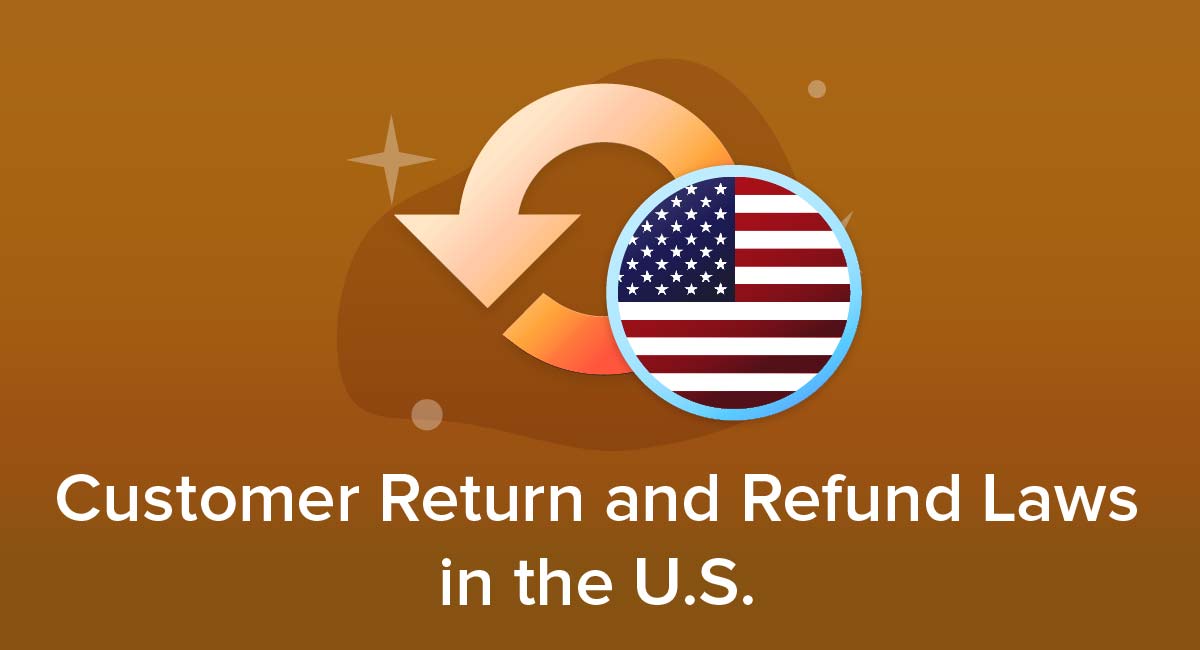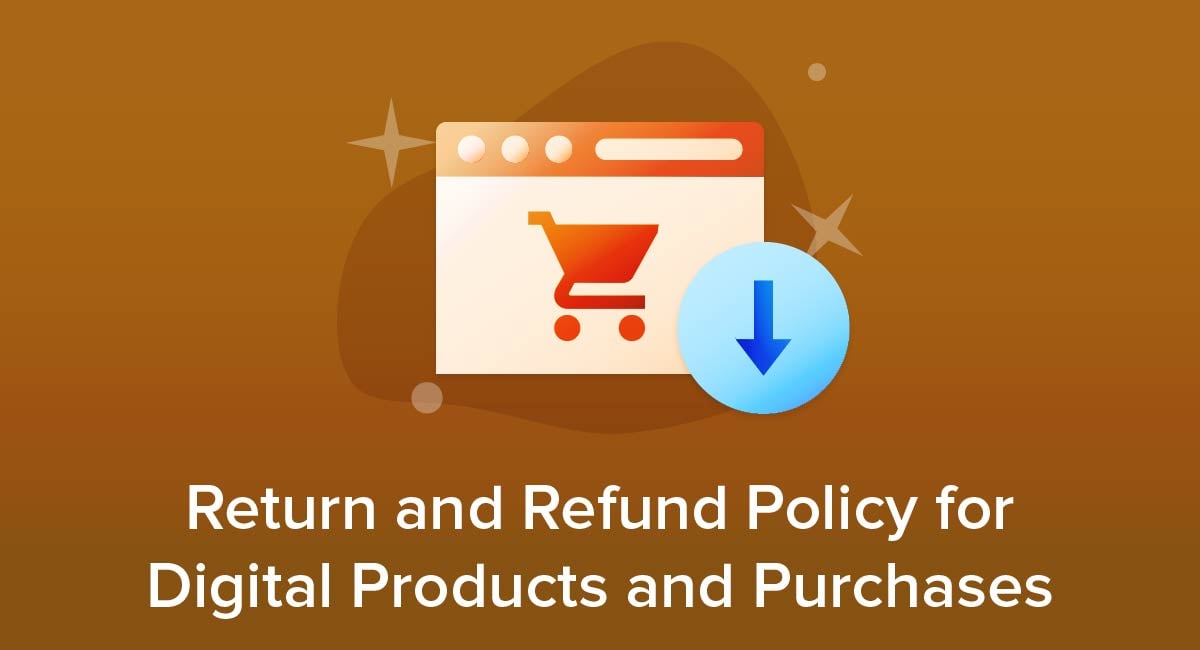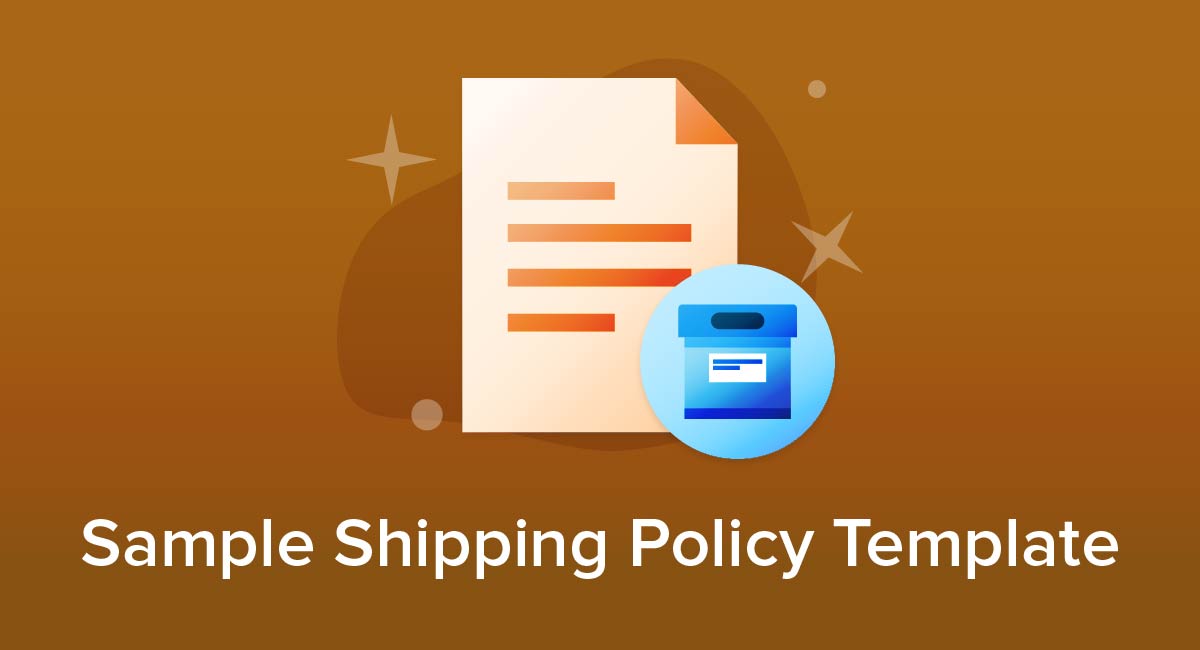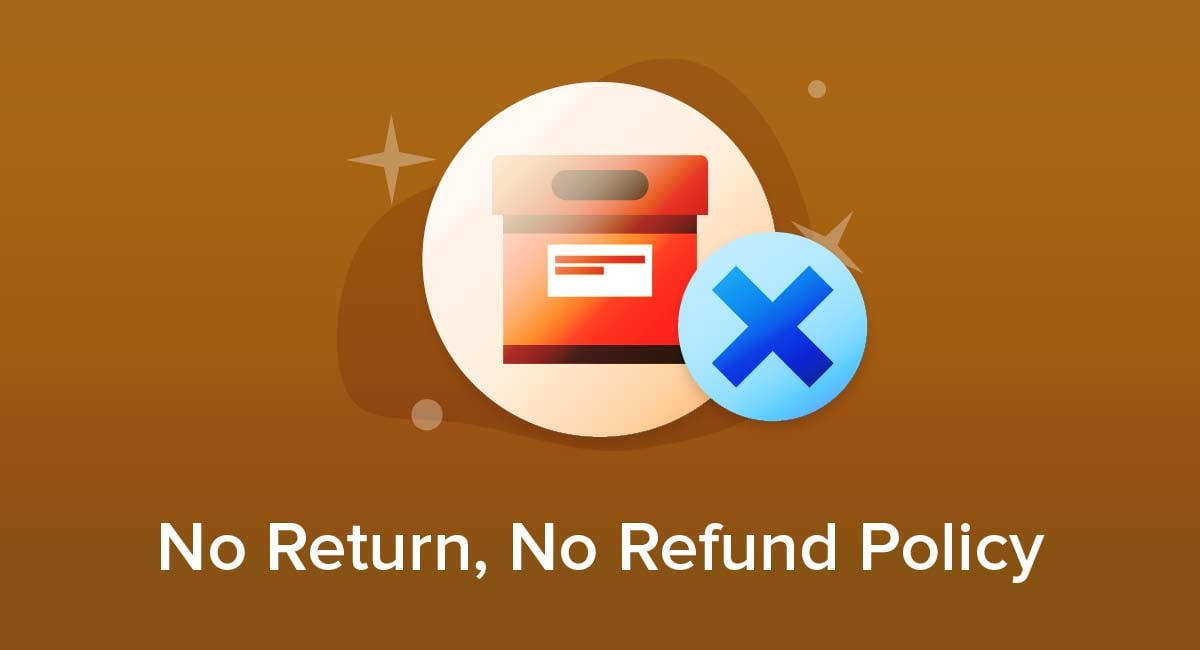
A No Return, No Refund Policy is a document that explains how you handle returns and refunds, and details any exceptions you have. Some of these points may be your business preferences, while others may be legally required.
Here's what you need to know about this important policy, and how to create and display your own.
Use FreePrivacyPolicy.com to generate the necessary legal agreements for your website/app:
- Free Privacy Policy Generator
- Free Terms and Conditions Generator
- Free Cookies Policy Generator
- Free Disclaimer Generator
- Free EULA Generator
- Free Return & Refund Policy Generator
You check our Free Cookie Consent to start making your business legally compliant with the Cookies Directive in the EU.
- 1. What is a No Return, No Refund Policy?
- 2. Why Have a No Return, No Refund Policy?
- 3. Do Any Laws Restrict No Return, No Refund Policies?
- 3.1. United States Laws
- 3.2. European Union & United Kingdom Laws
- 3.3. Canadian Laws
- 3.4. Australian Law
- 4. What to Include in a No Return, No Refund Policy
- 4.1. Statement of Principle
- 4.2. Exemptions: Legal
- 4.3. Exemptions: Goods
- 4.4. Exemptions: Time Limit
- 4.5. Your Returns Process
- 4.6. Services and Digital Goods
- 5. How to Display a No Return, No Refund Policy
- 6. Summary
What is a No Return, No Refund Policy?
A No Return, No Refund Policy is actually a type of Return and Refund Policy. It's just one where the content and title make clear that the company rarely allows returns or refunds.
Almost all businesses that sell anything have some type of policy that sets out when returns and refunds are and are not allowed, along with any conditions.
Not having a policy like this risks causing confusion for your customers who may be uncertain of what options they have, if any, when it comes to returns and refunds. This means that every sale could potentially carry the risk of disagreement or even legal action.
Potential customers who can't see when and how returns and refunds are allowed may even decide it's too risky to go ahead with a purchase and go shop elsewhere where the process is clearly disclosed to them.
You might assume simply writing the words "no returns, no refunds" would be enough to create a clear and concise policy. In practice, a No Return, No Refund Policy usually needs more detail than this.
Think of it more as a matter of emphasis. Having a standard Return and Refund Policy is like saying "Yes, we do allow returns and refunds, in the following circumstances." Having a No Return, No Refund Policy is like saying "We only allow returns and refunds in the following circumstances."
As long as you have all the necessary details, the legal effect is much the same.
Why Have a No Return, No Refund Policy?

The main reason to have a No Return, No Refund Policy is to achieve three goals, which might otherwise be hard to balance:
- Reduce the chances of customers attempting to return goods and/or get a refund in circumstances you don't allow. (Even refusing such an attempt can cost you staff time.)
- Comply with applicable consumer laws.
- Have customers feel you are being open and honest with them.
Again, a No Return, No Refund Policy has the same general aim and content as a standard Return and Refund Policy, which is telling customers when (and how) they can or cannot return goods for a refund. The main difference is establishing the principle that any return and refund is a rare exception in limited circumstances.
You could use a No Return, No Refund Policy in most types of business. It's arguably best suited to situations where, without such a policy, you might get an undesirably large number of return or refund requests.
This could include cases where the cost and effort of returning a good is particularly low or there's a bigger risk of customers seeking to take unfair advantage of your policy. Digital products often fall into these categories.
Do Any Laws Restrict No Return, No Refund Policies?

Many jurisdictions have laws that say you must offer refunds in certain circumstances. Commonly, this could include cases where goods are faulty or not as advertised.
These cases must be exceptions to your No Return, No Refund Policy. Laws may explicitly state, or have the implicit effect, that you must make customers aware of these exceptions.
Laws may vary on other points such as:
- Whether customers can get refunds on (non-faulty) goods if they buy them online or by mail order before seeing them
- Whether any goods are excluded from no-fault return rules
- Who covers the cost of returns
- What conditions you can impose on the returns process
- The timescale and form (eg cash or credit voucher) for issuing a refund
Though we've summarized some key laws from around the world below, you should always check the requirements in your area to make sure your policies are legally compliant.
United States Laws
The federal "cooling off rule" means customer usually have the right to cancel a purchase contract within three days if several conditions all apply:
- The cost was at least $25,
- The sale was a physical transaction (ie not online, mail order or by phone), and
- The sale was not at the seller's normal place of business (such as a store)
This means your No Return, No Refund Policy can't cover purchases that meet these conditions.
Individual state laws also cover refunds and returns. Generally customers have the right to return faulty goods, but the rules vary from state to state for other cases. The two main options include:
- It's entirely up to sellers whether to allow no-fault returns.
- Sellers can have their own policy (including "no return, no refunds") but must make it clear before a sale. If they don't do so, they must accept returns and give refunds. Depending on the state, this may only apply for a certain period after the sale.
European Union & United Kingdom Laws
The key rules on returns and refunds in the European Union come from the Consumer Rights Directive. This was passed in 2011 and set out principles that all EU countries implemented into their national laws by 2014. (Although the United Kingdom is no longer an EU country, it still has the same measures in its Consumer Contracts Regulations law.)
The key principle affects distance selling, meaning customers buying something online, over the phone or on the Internet. Customers have the right to cancel their contract and return goods for any reason between the moment they place the order and seven days after they receive the goods.
Some goods such as perishable items, underwear and personalized goods are exempt from this principle.
Canadian Laws
Canadian law doesn't require no-fault returns. The main rule is that if you do post any form of No Return, No Refund Policy, you must stick to it.
Australian Law
Australian law bars blanket "no refund" policies and signs, as these could mislead consumers about their legal right to get a refund for faulty goods.
If you want to limit returns/refunds, for example by refusing to accept them for goods that are not faulty, it's safer to present this information as a Return and Refund Policy rather than as a No Return, No Refund Policy.
What to Include in a No Return, No Refund Policy

Generally, a No Return, No Refund Policy should outline that you don't accept returns or issue refunds. Or, if you do, what your unique exceptions and policies surrouding this are.
Exactly what to include in a policy depends on what you want to say. The following points are worth considering.
Statement of Principle
Make clear that "no returns, no refunds" is your general principle. In other words, you will only accept returns and offer refunds in very specific cases as set out in your policy. This helps avoid any ambiguity.
Na Is The Name makes its point clear right away that it does not accept refunds or exchanges. It goes on to state that it only offers this if an item is defective, and after the company confirms this is the case:
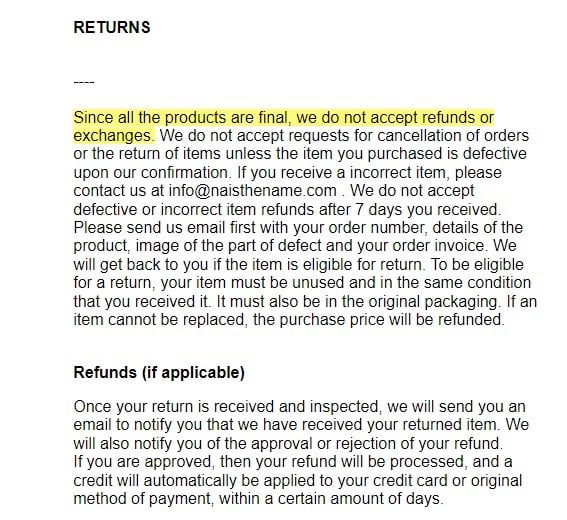
Exemptions: Legal
At the very minimum, you should say the No Return, No Refund Policy does not override the customer's legal rights. It's more useful to explain what these rights are, for example to get a refund for faulty goods.
Having such a statement reduces the chances you'll be accused of trying to mislead customers about their rights, undermining the effectiveness of the policy. It can also establish to potential customers that you act lawfully.
You can also present the law as a limiting factor, for example by saying that "no return, no refund" applies except where the law requires otherwise. This reduces the chances of you implying or the customer inferring that you are giving them any right to return that goes beyond the requirement of the law.
Tesco covers this point concisely:
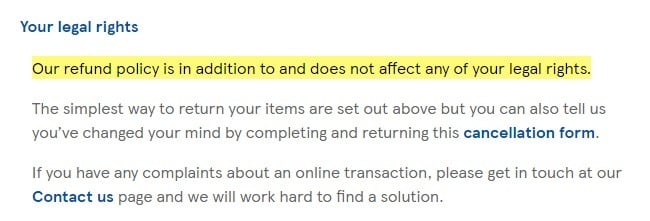
Exemptions: Goods
Make clear when particular goods are:
- Exemptions to your general policy of not allowing returns or refunds
- Not included in any special situations where you do allow returns or refunds
Usually the reasoning behind these exemptions should be clear, for example with goods such as opened underwear, worn earrings or personalized products that you wouldn't be able to resell. In other cases, it can build trust with users if you explain the exemption.
Agent Provocateur details some exceptions and explains why this is the case:

Exemptions: Time Limit
Explain any time limits that apply to exemptions to your usual policy. For example, you may allow a limited period to trial goods or services, after which you will not accept returns or refunds.
Google explains how time limits affect exemptions to its "no refund" policy:
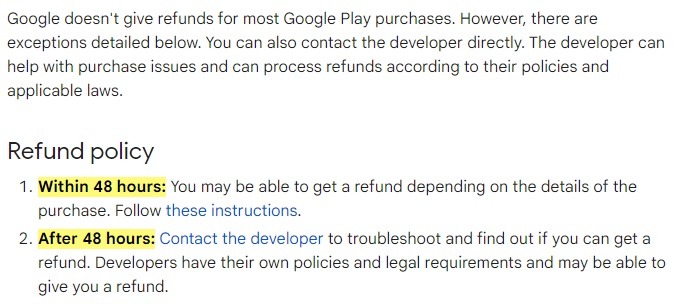
Your Returns Process
If you do have an exemption that allows returns and refunds in some situations, set out the process for making a return. Unless such returns are a legal requirement, you can usually put limits on this process.
For example, you could decide:
- How the customer must package goods for return
- What the time limit is for initiating and completing a return
- How the customer must send goods (eg a particular delivery service or with tracking), and who pays return shipping costs
- When you make the refund and how you pay it (eg cash, refund to payment card, store credit, gift voucher)
K.H. Packaging sets out some rules for returns:

Services and Digital Goods
Explain the logistics and consequences when your No Return, No Refund Policy (and any exemptions) apply to non-physical goods. Possible points could include:
- Any refund for an ongoing service or subscription will be proportionately reduced to cover the time that has already passed
- You will remotely deactivate or uninstall applications and other software that the customer returns for a refund
- After the return and refund occurs, the customer is no longer allowed to use or sell anything they have produced using your digital service
Squarespace details how its refunds depend on subscription plans and timings:
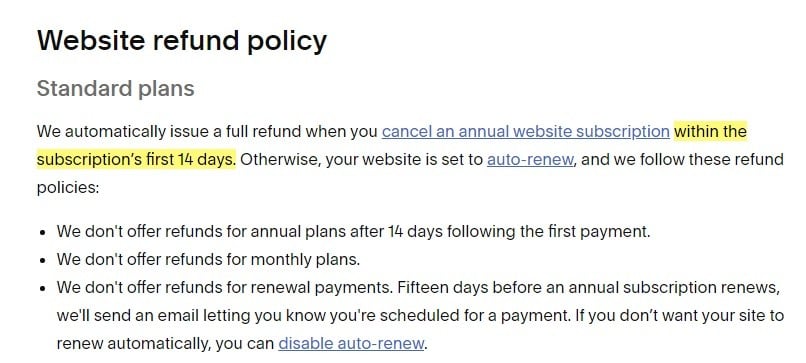
How that you have an idea of how to create your No Return, No Refund Policy, let's take a look at some ways you can display it to your customers or potential customers for maximum effectiveness.
How to Display a No Return, No Refund Policy

Most businesses that have a Return and Refund Policy will display it as a standalone document. In some cases, they may post it as a notice in stores as well as on a separate page on their website.
If you do this, display a link to your policy page in the website footer, as K.H. Packaging does here:
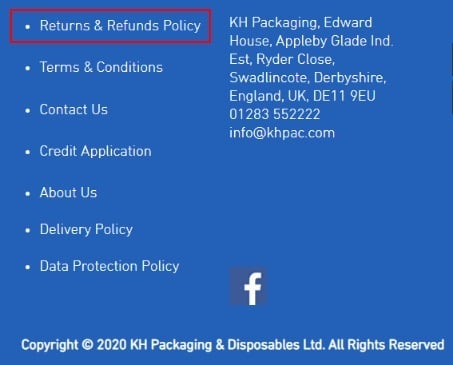
If you use the "no return, no refund" approach, a standalone document may work. However, in most cases your policy will be shorter than if you had a traditional Return and Refund Policy.
In this case, it may work better to include the information as part of a larger document, such as your Terms and Conditions agreement.
You can also cross-link policies, as Lush USA does here in its Terms of Use which makes note of, and then links to its Return and Exchange Policy:

If you do cover a "no return, no refund" stance within a separate policy, use clear sections and subheadings to make it easy for people to find the information, as Lush does above.
You could also make clear at the point of purchase (such as an online order form) that you have a general "no return, no refund" policy and then link to the relevant section of the agreement to display the full details.
Summary
Let's recap what you need to know about No Return, No Refund Policies:
- Having a clear policy on returns and refunds reduces legal disputes and builds trust with your customers.
- "No returns, no refunds" is the simplest such policy. Although you'll need more detail than just these four words, the approach clearly emphasizes that any returns and refunds are exceptions to the general principle. It should reduce the number of return requests from people not understanding your rules.
- While rules vary in different jurisdictions, generally you must legally accept returns and requests on faulty goods, regardless of your policy.
- The rules vary on "no-fault" returns. In some cases, you must accept them unless you have a clear No Return, No Refund Policy.
-
Possible points to include in a No Return, No Refund Policy include:
- A clear statement of the general principle
- A note that the policy doesn't override legal rights
- Any restrictions you place on the returns you do accept, for example restrictions on the type of goods, a time limit, or the process of completing returns
- Whether any special rules apply to digital goods
- You could publish a No Return, No Refund Policy as a standalone document. Often it will be short enough to include in a longer document such as your Terms and Conditions agreement, but make sure it's clearly signposted.
- If you publish the policy separately, include a link to it in your website's footer so customers and potential customers can quickly find it at any time.
